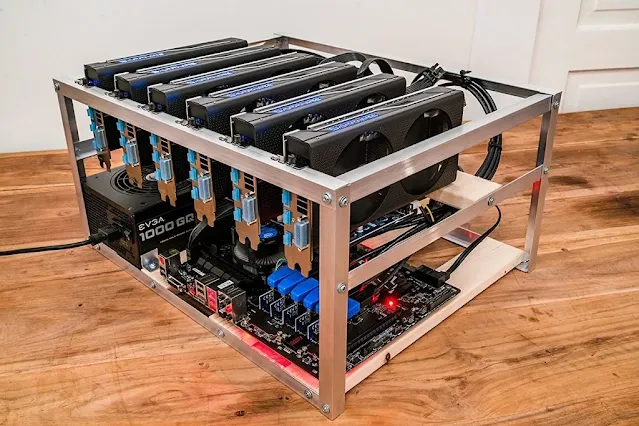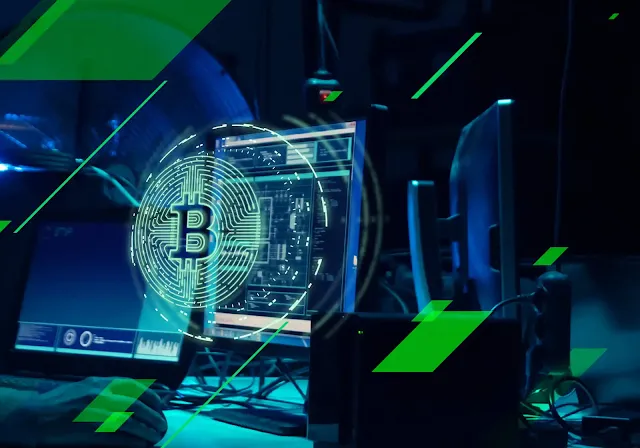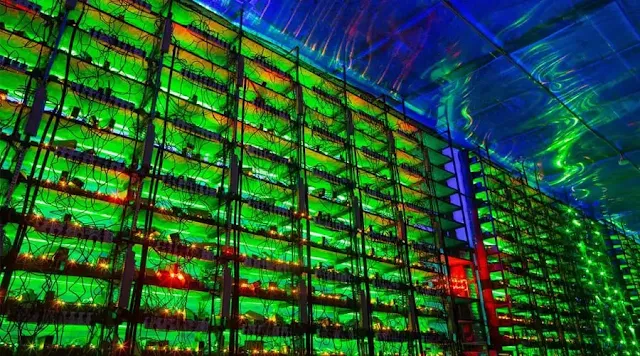.webp) |
| Mining Cryptocurrency |
In the digital age, cryptocurrency mining has emerged as a captivating and potentially profitable venture, attracting countless individuals and entities to explore this brave new world. Cryptocurrency mining is the process by which transactions on a blockchain are validated, and new coins are minted. It plays a crucial role in securing the integrity of blockchain networks like Bitcoin and Ethereum. Miners use computational power to solve complex mathematical problems, and in return, they are rewarded with newly created cryptocurrency tokens.
This article is a comprehensive guide for beginners who are interested in starting their cryptocurrency mining journey. We will cover everything from understanding what cryptocurrency mining is to choosing the right hardware, setting up a mining rig, selecting mining software, joining a mining pool, and optimizing mining operations.
Introduction
In the ever-evolving landscape of the digital age, cryptocurrency mining has become a focal point of attention. The allure of transforming digital resources into real-world wealth has drawn the interest of countless individuals and entities to explore this brave new world. But before we delve into the nitty-gritty of how to start cryptocurrency mining, let's begin with the basics.
What is Cryptocurrency Mining?
Cryptocurrency mining is the process of validating transactions on a blockchain and creating new coins. It plays a crucial role in the security and functionality of blockchain networks. Miners use their computational power to solve complex mathematical problems, a process known as "proof of work," and in return, they are rewarded with newly created cryptocurrency tokens. These tokens are then added to the blockchain as a reward for the miner's efforts.
The importance of cryptocurrency mining cannot be overstated. It ensures the validity of transactions and prevents fraud by verifying that the sender has the necessary funds and is not attempting to double-spend. Without miners, blockchain networks would be susceptible to manipulation and centralization, which could compromise the integrity of the entire system.
The Benefits and Profitability of Cryptocurrency Mining
.webp) |
| Profitability of Cryptocurrency Mining |
Cryptocurrency mining offers a range of benefits and the potential for profitability. Let's delve into these advantages and why they make mining an attractive endeavor for many:
1. Decentralization and Security
One of the primary benefits of cryptocurrency mining is its contribution to the decentralization and security of blockchain networks. Miners validate transactions and maintain the ledger, reducing the risk of centralization and potential manipulation. In a decentralized network, no single entity has control over the blockchain, making it resistant to censorship and tampering.
2. Profit Potential
Cryptocurrency mining offers several avenues for generating profits:
- Generation of New Cryptocurrency: Mining allows individuals to earn cryptocurrency rewards, which can appreciate in value over time. The potential for significant returns exists, especially with popular cryptocurrencies like Bitcoin and Ethereum.
- Transaction Fees: In addition to newly generated coins, miners also receive transaction fees for processing transactions. These fees can add up, particularly when network activity is high.
- Hedging Against Market Volatility: Cryptocurrency mining provides a way to accumulate digital assets, potentially acting as a hedge against market volatility or economic instability.
3. Learning and Engagement
Mining cryptocurrencies provide an opportunity to learn about the inner workings of blockchain technology. This firsthand experience can be invaluable for those interested in the blockchain and crypto space. It's an engaging way to gain practical knowledge of how transactions are processed, blocks are added to the chain, and consensus is reached.
4. Long-term Investment
Cryptocurrency mining, when approached strategically, can become a long-term investment. As the market evolves and matures, the value of mined coins may appreciate, potentially leading to substantial profits. By accumulating cryptocurrency over time, miners may benefit from price appreciation.
5. Supporting Blockchain Networks
By participating in mining, individuals contribute to the overall security and resilience of blockchain networks. This active role can be personally rewarding, knowing you're playing a part in the future of digital finance. Cryptocurrency networks rely on miners to maintain their integrity and prevent fraud, making it a critical component of the ecosystem.
Getting Started with Cryptocurrency Mining
Now that we've established the significance of cryptocurrency mining and its potential benefits, it's time to get into the nitty-gritty of starting your mining journey. We'll break down the process into actionable steps that beginners can follow to get started.
1. Research and Select the Right Cryptocurrency to Mine
.webp) |
| Best cryptocurrencies to mine |
The first step in starting your cryptocurrency mining journey is choosing the right cryptocurrency to mine. Not all cryptocurrencies are equally profitable or suitable for mining. Factors like the coin's popularity, market demand, and the hardware you have can influence this decision.
Importance of Choosing the Right Cryptocurrency:
- Profitability: Different cryptocurrencies offer varying levels of profitability. To make an informed choice, research historical data and use mining profitability calculators to estimate potential earnings.
- Mining Difficulty: The complexity of mining differs from one cryptocurrency to another. It's essential to choose a cryptocurrency with a manageable level of difficulty, especially as a beginner.
- Personal Interest: Consider mining a cryptocurrency that aligns with your interests and beliefs. Your enthusiasm for a project can be a strong motivator.
Suggestions for Popular Cryptocurrencies to Consider:
There is a multitude of cryptocurrencies to choose from, but as a beginner, it's often best to start with well-established and popular options:
- Bitcoin (BTC): Bitcoin is the first and most well-known cryptocurrency. It offers the potential for substantial rewards, but it has a high level of mining difficulty and requires powerful hardware, typically ASICs.
- Ethereum (ETH): Ethereum is a popular choice for GPU mining. It is a well-established blockchain platform with a strong community.
- Litecoin (LTC): Litecoin is often considered the "silver" to Bitcoin's "gold." It is less demanding in terms of hardware, making it a good choice for beginners.
Tips for Conducting Research:
To make an informed decision, conduct thorough research using various resources:
- Websites: Explore cryptocurrency websites, including the official sites of the cryptocurrencies you're interested in. These sites provide valuable information about the project, its technology, and its development team.
- Forums: Participate in cryptocurrency forums and communities. These platforms offer insights, discussions, and real-world experiences from miners and crypto enthusiasts.
- Mining Profitability Calculators: Use online mining profitability calculators to estimate potential earnings. These calculators consider factors like hardware power, electricity costs, and network difficulty to provide estimates.
2. Choose the Right Mining Hardware
.webp) |
| Mining Hardwares |
Once you've decided on the cryptocurrency you want to mine, the next step is to choose the right mining hardware. Different cryptocurrencies and mining algorithms require specific types of hardware. Understanding the options available and their respective pros and cons is crucial.
Explanation of Different Types of Mining Hardware:
There are three main types of mining hardware:
- Application-Specific Integrated Circuits (ASICs): ASIC miners are specialized hardware designed for mining a specific cryptocurrency efficiently. They offer high performance but are less versatile. ASICs are best suited for cryptocurrencies like Bitcoin.
- Graphics Processing Units (GPUs): GPUs are versatile and suitable for mining a wide range of cryptocurrencies, including popular ones like Ethereum and Litecoin. They provide a balance between performance and versatility.
- Central Processing Units (CPUs): CPUs are the least powerful option and are not recommended for serious mining due to their low performance. However, they can still be used for mining certain cryptocurrencies.
Discussion of the Pros and Cons:
ASICs:
- Pros: Exceptional mining performance, ideal for specific cryptocurrencies, energy-efficient.
- Cons: Expensive, limited versatility (dedicated to one cryptocurrency).
GPUs:
- Pros: Versatile, capable of mining multiple cryptocurrencies, lower initial cost compared to ASICs.
- Cons: Less efficient than ASICs for specific cryptocurrencies, may require more power.
CPUs:
- Pros: Low initial cost, suitable for experimentation.
- Cons: Extremely low mining performance, not cost-effective for profitable mining.
Tips for Assessing Mining Hardware Requirements:
The choice of mining hardware depends on several factors:
- Chosen Cryptocurrency: Your choice of hardware should align with the cryptocurrency you plan to mine. Ensure compatibility with the cryptocurrency's mining algorithm.
- Budget: Consider your budget when selecting hardware. ASICs, while efficient, can be expensive, while GPUs offer a more affordable entry point.
- Electricity Costs: Assess your local electricity costs, as power consumption is a significant consideration. Efficient hardware can lead to lower electricity bills.
- Cooling and Noise: Be prepared for the heat generated by mining hardware. Adequate cooling is necessary to prevent overheating. Noise can also be a factor, so consider your mining location.
3. Set Up a Mining Rig
 |
| Mining rig |
Setting up a mining rig involves assembling the hardware, connecting GPUs, power supply units, and fans. Key components for a mining rig include a motherboard, CPU, RAM, and storage. Ensure proper cooling and power supply to optimize your mining rig's performance.
Step-by-Step Guide on Assembling the Mining Rig Hardware:
1. Select a Suitable Location: Choose a well-ventilated and cool location for your mining rig. Consider the availability of power outlets and a stable internet connection.
2. Assemble the Components:
- Motherboard: Install the motherboard in the mining rig frame.
- CPU: Attach the CPU to the motherboard.
- RAM: Insert the RAM modules into their slots.
- Storage: Connect a storage device (typically a solid-state drive or hard drive) to the motherboard.
- Power Supply Unit (PSU): Connect the PSU to the motherboard and other components.
- Graphics Cards (GPUs): Install the GPUs in their respective PCIe slots.
- Cooling: Attach fans and cooling solutions to regulate temperature.
3. Connect Cables:
- Connect power cables to the GPUs and the PSU.
- Attach data cables for storage devices.
4. Secure Connections: Ensure all components are securely connected and that cables are well organized to prevent overheating or accidents.
Tips for Optimizing the Mining Rig's Cooling and Power Consumption:
- Cooling Solutions: Adequate cooling is essential to prevent overheating. Consider using additional fans or cooling systems to maintain an optimal operating temperature.
- Power Supply: Ensure your power supply can handle the load of your mining rig. Invest in a high-quality PSU to prevent power-related issues.
- Cable Management: Proper cable management not only improves the aesthetics of your rig but also helps with airflow, reducing heat buildup.
- Remote Monitoring: Consider using remote monitoring tools to keep an eye on your rig's temperature and performance from a distance.
4. Install Mining Software
 |
| Mining Software |
Choosing the right mining software is crucial to ensure that your mining rig functions as intended. Mining software serves as the interface between your hardware and the blockchain network. Popular options include CGMiner, EasyMiner, and Claymore. Here's a step-by-step guide to installing and configuring mining software:
Explanation of Popular Mining Software Options:
- CGMiner: CGMiner is a widely used, open-source mining software that supports various mining hardware. It's known for its stability and versatility.
- EasyMiner: EasyMiner is a user-friendly mining software with a graphical interface. It's ideal for beginners and offers features like automatic detection of available mining hardware.
- Claymore: Claymore's Dual Miner is known for its efficiency when mining certain cryptocurrencies. It supports both AMD and NVIDIA GPUs.
Step-by-Step Guide on Downloading and Installing the Chosen Mining Software:
- Download: Visit the official website of your chosen mining software and download the latest version.
- Installation: Run the installation file and follow the on-screen instructions. Make sure to download the software onto the mining rig.
- Configuration: After installation, open the mining software and configure it as follows:
- Select your mining pool.
- Enter your wallet address where you want to receive your rewards.
- Set up any additional parameters specific to your hardware or mining pool.
Tips for Configuring Mining Software:
- Choosing a Mining Pool: Select a reputable mining pool that aligns with your chosen cryptocurrency. Ensure that the pool has a low fee structure and a good track record of consistent payouts.
- Wallet Configuration: Use a secure cryptocurrency wallet to receive your mining rewards. Ensure that the wallet is compatible with the cryptocurrency you're mining.
- Monitoring: Regularly monitor the performance of your mining rig through the software interface. Keep an eye on metrics such as hashrate, temperature, and accepted shares.
5. Join a Mining Pool
 |
| Mining Pool |
Mining solo, while possible, is a challenging endeavor that requires significant computational power. Most miners opt to join mining pools, where they combine their resources and share rewards based on their contribution. Here's an explanation of the benefits of joining a mining pool and suggestions for popular mining pools based on the chosen cryptocurrency:
Explanation of the Benefits of Joining a Mining Pool:
- Increased Chances of Earning Rewards: Mining pools provide a consistent stream of rewards, as miners collectively work to solve blocks and receive payouts.
- Reducing Variance: Mining alone can lead to significant variability in earnings due to the unpredictability of finding blocks. In a pool, rewards are more consistent, smoothing out income.
- Lower Barrier to Entry: Mining pools are open to miners with less powerful hardware, as they contribute to the pool's combined computational power.
Suggestions for Popular Mining Pools Based on the Chosen Cryptocurrency:
- Bitcoin: Consider joining well-established mining pools like Slush Pool, F2Pool, or Antpool for Bitcoin mining.
- Ethereum: For Ethereum mining, pools like Ethermine, F2Pool, and SparkPool are reputable options.
- Litecoin: Litecoin miners can explore pools such as LitecoinPool and ProHashing.
Step-by-Step Guide on Joining and Configuring a Mining Pool:
- Registration: Visit the chosen mining pool's website and register for an account.
- Pool Selection: Select the specific pool that aligns with your chosen cryptocurrency. You'll find this information on the pool's website.
- Configuration: In your mining software, enter the pool's address and your login details. These credentials will be provided by the pool during registration.
- Mining: Start your mining software, and it will automatically connect to the pool and begin working on validating transactions and solving blocks.
6. Start Mining
 |
| Start Mining Cryptocurrency |
With your mining rig set up, mining software configured, and connected to a mining pool, you're ready to start mining. Here's an explanation of the process of initiating the mining operation and tips for monitoring it effectively:
Explanation of the Process of Initiating the Mining Operation:
- Mining Software: Ensure that your mining software is running and connected to the chosen mining pool.
- Mining Process: Your mining rig will start solving complex mathematical problems, a process known as "hashing." Successful solutions are submitted to the mining pool for verification.
- Rewards: As a miner, you'll receive rewards in the form of cryptocurrency tokens. The rewards are sent to the wallet address you provided during the configuration of the mining software.
Tips for Monitoring the Mining Process:
- Hashrate: Keep an eye on your hashrate, which indicates the computational power of your mining rig. It's a key metric that affects your mining efficiency and rewards.
- Temperature: Regularly monitor the temperature of your mining rig's components, particularly the GPUs. Overheating can lead to hardware damage.
- Efficiency: Pay attention to the efficiency of your mining rig. You want to ensure that it's running smoothly and not encountering issues.
- Accepted Shares: Keep track of the number of accepted shares submitted to the pool. A higher number of accepted shares indicates a well-functioning mining rig.
Suggestions for Troubleshooting Common Mining Issues:
Mining may encounter challenges, but most issues can be resolved with proper troubleshooting. Here are some common problems and how to address them:
- Hardware Failures: Check for loose connections, damaged components, or overheating. Replace or repair components as needed.
- Software Errors: Update your mining software to the latest version and ensure that your configurations are correct.
- Internet Connectivity: Stable internet connection is crucial. If you experience disconnections, investigate your network or contact your internet service provider.
- Pool Connection Issues: If you encounter issues with the pool, verify your settings, and consider switching to a different pool if the problem persists.
- Low Hashrate: Low hashrate can be caused by outdated drivers, incorrect configurations, or hardware issues. Address these factors to boost performance.
7. Monitor and Optimize Mining Operations
 |
| Optimize Mining Operations |
Regular monitoring and optimization are essential for maintaining profitability in cryptocurrency mining. The dynamic nature of the cryptocurrency market requires miners to adapt to changing conditions. Here's an explanation of the importance of monitoring and optimizing mining operations, along with tips for achieving this:
Explanation of the Importance of Monitoring and Optimizing Mining Operations:
- Market Conditions: Cryptocurrency markets are known for their volatility. Regular monitoring allows miners to make informed decisions based on market conditions.
- Profitability: As difficulty levels change, it's crucial to optimize your mining operations to maintain or increase profitability.
- Efficiency: Monitoring can help identify any performance issues in your mining rig, allowing you to optimize its efficiency.
- Network Upgrades: Be aware of potential network upgrades or forks that may require you to update your mining software or make other adjustments.
Tips for Monitoring Profitability and Adjusting Mining Strategies Based on Market Conditions:
- Regularly Check Earnings: Monitor your earnings from mining and compare them to your expenses, including electricity costs. Calculate your ROI and adjust your strategy accordingly.
- Stay Informed: Keep up with news and updates in the cryptocurrency world, as these can affect the profitability of your mining operations.
- Diversify Your Portfolio: Consider diversifying your mining efforts by exploring multiple cryptocurrencies. This can reduce the risk associated with fluctuations in a single coin's value.
- Optimize Hardware: As technology evolves, consider upgrading your mining hardware to stay competitive and maintain profitability.
- Efficiency Enhancements: Explore advanced settings in your mining software to optimize efficiency. Overclocking your GPUs, adjusting fan speeds, and fine-tuning settings can improve performance.
Conclusion
Starting cryptocurrency mining is an exciting journey filled with opportunities and challenges. It's essential to research and plan carefully, select the right hardware and software, and monitor and optimize your mining operations. While mining may present certain risks and challenges, your perseverance and commitment to learning and adapting in this dynamic industry can lead to rewarding results.
Cryptocurrency mining is not only a source of potential profit but also an opportunity to engage with blockchain technology and actively contribute to the security and decentralization of blockchain networks. So, are you ready to start your cryptocurrency mining adventure? Remember that success in cryptocurrency mining often comes with continuous learning and dedication. As you embark on your mining journey, stay informed, stay patient, and stay adaptable to the ever-evolving world of cryptocurrency. Happy mining!




Post a Comment